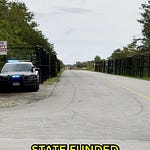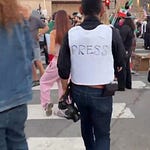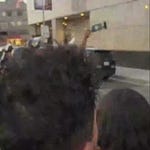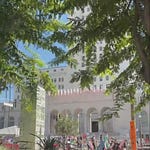By Nick Valencia | October 22, 2025
LOS ANGELES — The asphalt still radiates late-autumn heat as the crowd gathers outside the Metropolitan Detention Center.
The concrete tower has become both a symbol and a staging ground.
Hand-painted signs flap against a phalanx of police acting as a barricade. A chant begins, low and rhythmic—then the bullhorn crackles, and voices rise to meet the downtown skyline.
“We’re the working class in the United States of America,” one man shouts.
For nearly five months, they’ve been here—activists, families of detainees, and ordinary Angelenos who say the federal government has turned an urban prison into a deportation hub. The protest began on June 6, sparked by reports that ICE was using the facility to process migrants swept up in raids across Southern California. Since then, it’s grown into one of the longest-running acts of civil resistance in the country.
When I arrived, the street was already cordoned off. We had come from the No Kings 2.0 protest and followed reports of a skirmish between police and a group of activists who had taken their fight to the MDC. Video sent to me showed a blurry image of an LAPD SUV that appeared to drive-away brushing a demonstrator who was now lying limp on the ground.
Yellow tape fluttered in the wind, marking the invisible line between protest and punishment. The demonstrators said the closure came hours before anyone assembled—“prior restraint,” they called it, a preemptive move to push them back nearly 150 yards from the MDC entrance.
“They do this anytime they know there’s a big protest planned,” one organizer who the police have nicknamed Harley Quinn told me. “They did it on Mexican Independence Day, too. They’ll stand there until they either force us away or take the tape down.”
She was dressed in a cosplay Harley Quinn outfit with sparkly gems on her teeth that capped her canines. “Might as well dress the part.”
She’s been here from the start. Since June 6. In those months, she’s watched the police presence evolve—from the LAPD and sheriff’s deputies who first confronted protesters, to Department of Homeland Security officers who now patrol the perimeter.
“I’ve seen them punch women in the face,” she said flatly. “I’ve seen them take people into prison for up to five days on illegal charges. I’ve seen women and children in shackles being put into vans at three in the morning.”
To her, the pattern is unmistakable: local and federal agencies cooperating to stifle dissent, under the cover of enforcing immigration law. “LAPD works with DHS and ICE to protect them over their own citizens,” she said.
The Price of Documentation
In recent months, the standoff has moved.
A battle sometimes mimicking urban warfare in the streets has turned to legal battles in the courtroom. Protesters accuse federal prosecutors of overcharging activists to make examples of them, pursuing felonies that later collapse when the evidence is tested.
“Just to put it in perspective,” Harley Quinn told me, “the guy who started the Palisades Fire is facing 20 years. Our friend Alex was also facing 20 years—for being an activist.”
Another woman, she said, remains jailed without bail for filming ICE agents outside the facility. “She’s facing five years in federal prison for documenting a federal officer,” the organizer said. “They’re trying to make a national example out of her.”
The First Amendment protects the right to record public officials performing their duties. Yet across the country, those who point their cameras at law enforcement are finding themselves charged with “interference” or “obstruction.” The chilling effect is unmistakable—especially among independent journalists.
“Mainstream reporters turn their cameras away,” she added. “It’s only independent journalists that are covering it.”
When the Sun Goes Down
By the time I went live, the sun was sliding behind Commerical and Alameda. The crowd thinned, but the tension thickened. Protesters call it police “happy hour”—the moment, they say, when officers act most aggressively. Once daylight disappears and fewer cameras are rolling.
Everyone here knows the risk. They also know why they stay: because in the absence of transparency, visibility itself becomes a form of protection.
“We’re allowed to document,” the organizer reminded the crowd. “We have a right to be here.”
Fifteen minutes after we left, police declared an unlawful assembly. Moments later, mounted officers charged the crowd, unleashing violent force on demonstrators—including members of the press.










